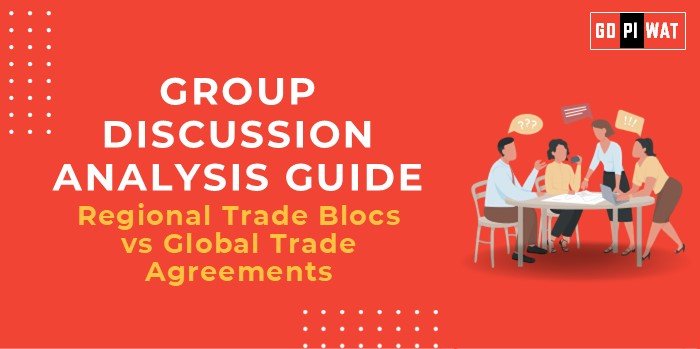📋 Group Discussion (GD) Analysis Guide
🌐 Introduction to the Topic
- 📌 Opening Context: Regional trade blocs like the European Union (EU), ASEAN, and MERCOSUR have gained prominence, raising the question of whether they can supplant global trade agreements like the World Trade Organization (WTO). This debate explores the efficacy, inclusivity, and long-term sustainability of both frameworks.
- 📖 Topic Background: Established in 1995, the WTO governs global trade through a multilateral system involving 164 nations. In contrast, regional trade blocs focus on specific geographic areas to promote economic integration, often bypassing global-level negotiations.
📊 Quick Facts and Key Statistics
🌍 WTO Members: 164 countries, covering 98% of global trade (2023).
🌐 Regional Trade Bloc Growth: Over 50 active trade blocs worldwide (World Bank, 2023).
💹 EU Trade Impact: 14.9% of global trade share (Eurostat, 2023).
🌏 RCEP Scope: Largest trade bloc covering 30% of global GDP (2023).
📉 Global Trade Slowdown: WTO projects only 1.7% trade growth in 2024.
🌐 Regional Trade Bloc Growth: Over 50 active trade blocs worldwide (World Bank, 2023).
💹 EU Trade Impact: 14.9% of global trade share (Eurostat, 2023).
🌏 RCEP Scope: Largest trade bloc covering 30% of global GDP (2023).
📉 Global Trade Slowdown: WTO projects only 1.7% trade growth in 2024.
👥 Stakeholders and Their Roles
- 🏛️ Regional Trade Blocs: Promote regional integration, negotiate preferential terms, and resolve localized disputes.
- 🌍 WTO and Global Institutions: Ensure fair trade practices, resolve disputes globally, and promote multilateral trade.
- 📌 Governments: Use trade blocs to bolster national economies while balancing global trade commitments.
- 🛒 Businesses and Consumers: Benefit from reduced tariffs and market access but may face challenges due to fragmented regulations.
🏆 Achievements and Challenges
✨ Achievements:
- 🤝 Economic Integration: Trade blocs like the EU and ASEAN foster deep economic integration.
- 💰 Tariff Reductions: RCEP reduced tariffs for its 15 member countries, enhancing trade flows.
- ⏱️ Timely Action: Regional agreements often act faster than global negotiations stalled by conflicts among nations.
⚠️ Challenges:
- 📉 Exclusivity: Regional blocs create exclusivity, limiting non-member participation.
- ⚖️ Fragmentation: Risks undermining global trade norms established by the WTO.
- 🌍 Equity Issues: Smaller economies may struggle to gain equitable terms within regional blocs.
🌍 Global Comparisons:
- 🇪🇺 EU: A successful model of political and economic integration.
- 🇺🇸 NAFTA/USMCA: Limited scope but successful in reducing North American trade barriers.
Case Studies:
- 🌏 RCEP: Facilitates Asia-Pacific trade but criticized for excluding the US and India.
- 🌍 WTO: Doha Round’s failure to reach consensus highlights global negotiation challenges.
📢 Structured Arguments for Discussion
- ✅ Supporting Stance: “Regional trade blocs are more efficient and adaptable than global agreements, addressing local needs better.”
- ❌ Opposing Stance: “Global trade agreements ensure inclusivity and standardization, critical for equitable trade.”
- ⚖️ Balanced Perspective: “Regional blocs complement global trade agreements, but neither can wholly replace the other.”
🧠 Effective Discussion Approaches
- 🎯 Opening Approaches:
- “With over 50 active trade blocs worldwide, is global trade losing its cohesive framework?”
- “The rise of RCEP and EU shows the efficiency of regional trade blocs, but does this fragment global trade?”
- 🤝 Counter-Argument Handling:
- Use examples like the WTO’s dispute resolution mechanism or RCEP’s efficiency to show strengths and weaknesses of each.
📊 Strategic Analysis of Strengths and Weaknesses
- 🌟 Strengths:
- Regional trade blocs: Faster negotiations, targeted benefits.
- Global trade agreements: Inclusivity, global standardization.
- ⚠️ Weaknesses:
- Regional trade blocs: Exclusion of non-members, limited scope.
- Global agreements: Slow progress, political conflicts.
- 📈 Opportunities: Synergy between regional and global systems for balanced growth.
- ⚡ Threats: Trade wars, economic nationalism.
🎓 Connecting with B-School Applications
- 💼 Real-World Applications: Explore international business strategies leveraging regional trade agreements.
- 📚 Sample Interview Questions:
- “Can regional trade blocs accelerate economic growth for smaller nations?”
- “What are the WTO’s challenges in adapting to the rise of trade blocs?”
- 💡 Insights for Students:
- Examine the impact of regional agreements on global supply chains and market entry strategies.


